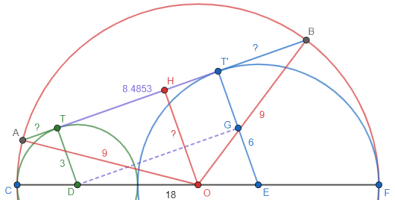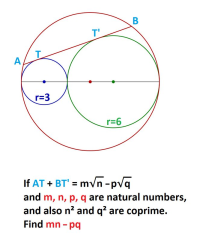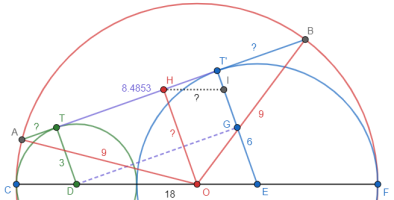You are using an out of date browser. It may not display this or other websites correctly.
You should upgrade or use an alternative browser.
You should upgrade or use an alternative browser.
I need your help: If AT+BT' = m√n-p√q, m,n,p,q natural, n^2, q^2 coprime, find mn-pq.
- Thread starter Seyed
- Start date
- Joined
- Feb 4, 2004
- Messages
- 16,583
Hi,
I hope somebody can help me to solve this problem.
I really appreciate your help.
View attachment 36960
What are your thoughts? What have you tried? How far have you gotten? ("Read Before Posting")
Please be complete. Thank you!
Hi,What are your thoughts? What have you tried? How far have you gotten? ("Read Before Posting")
Please be complete. Thank you!
I've read the "Read before posting".
I could only calculate the TT' and then stuck there. I think the distances between T and T' won't help me much.
By the way I'm too old to be a student and this isn't a homework.
Thank you.
Dr.Peterson
Elite Member
- Joined
- Nov 12, 2017
- Messages
- 16,089
Try adding the red lines for the next step (finding AB):I could only calculate the TT' and then stuck there. I think the distances between T and T' won't help me much.

Similar triangles will help.
One reason we ask for background information (such as whether you are a student) is that we have no other way to see how old your are or what you are doing! It may be obvious to you ...By the way I'm too old to be a student and this isn't a homework.
On the other hand, the way this problem is posed, it looks very much like some sort of contest problem aimed at students (asking a question that makes it impossible to work backward from the answer to a solution, or to check the answer, even if it were multiple choice).
I've no problem with you asking about my background and whether I am student or not, in fact I think this is good and I agree with this policy.Try adding the red lines for the next step (finding AB):
View attachment 36969
Similar triangles will help.
One reason we ask for background information (such as whether you are a student) is that we have no other way to see how old your are or what you are doing! It may be obvious to you ...
On the other hand, the way this problem is posed, it looks very much like some sort of contest problem aimed at students (asking a question that makes it impossible to work backward from the answer to a solution, or to check the answer, even if it were multiple choice).
I honestly don't know what the person who asked this question had in his mind, all I know that he is a student and I sometimes help him with geometry questions but this time I could not help him and I thought may be I can get help in here.
I should study your solution and see if I can understand it.
Thank you
Dr.Peterson
Elite Member
- Joined
- Nov 12, 2017
- Messages
- 16,089
Ah! You didn't say you were asking on behalf of someone else.I honestly don't know what the person who asked this question had in his mind, all I know that he is a student and I sometimes help him with geometry questions but this time I could not help him and I thought may be I can get help in here.
Yes, we'll give you hints (more if needed), and you can pass them on to the student so he, too, can learn to solve it himself.
(I have solved the whole problem, by drawing one more extra line.)
I didn't ask on behalf of that student, it is in fact my problem now because I couldn't solve it for him and this problem is really bothering me and I am curious to know the solution.Ah! You didn't say you were asking on behalf of someone else.
Yes, we'll give you hints (more if needed), and you can pass them on to the student so he, too, can learn to solve it himself.
(I have solved the whole problem, by drawing one more extra line.)
I really appreciate it to have more hints or if necessary the whole solution.
Thank you.
Last edited:
Dr.Peterson
Elite Member
- Joined
- Nov 12, 2017
- Messages
- 16,089
I'll just make the second hint more specific:
Here I added HI, parallel to CF. There are now several similar triangles, with hypotenuse DE, DO, and HI, which you can use to determine various lengths.
I showed this to a colleague (it's a slow day) and she was impressed by the complexity of the work.
By the way, you may enjoy reading more about this figure, which arises in many interesting problems:

 en.wikipedia.org
en.wikipedia.org

Here I added HI, parallel to CF. There are now several similar triangles, with hypotenuse DE, DO, and HI, which you can use to determine various lengths.
I showed this to a colleague (it's a slow day) and she was impressed by the complexity of the work.
By the way, you may enjoy reading more about this figure, which arises in many interesting problems:

Arbelos - Wikipedia

Arbelos -- from Wolfram MathWorld
The term "arbelos" means shoemaker's knife in Greek, and this term is applied to the shaded area in the above figure which resembles the blade of a knife used by ancient cobblers (Gardner 1979). Archimedes himself is believed to have been the first mathematician to study the mathematical...
mathworld.wolfram.com
Thank you, I managed to calculate AT and BT'.I'll just make the second hint more specific:
Here I added HI, parallel to CF. There are now several similar triangles, with hypotenuse DE, DO, and HI, which you can use to determine various lengths.
I showed this to a colleague (it's a slow day) and she was impressed by the complexity of the work.
By the way, you may enjoy reading more about this figure, which arises in many interesting problems:

Arbelos - Wikipedia
en.wikipedia.org

Arbelos -- from Wolfram MathWorld
The term "arbelos" means shoemaker's knife in Greek, and this term is applied to the shaded area in the above figure which resembles the blade of a knife used by ancient cobblers (Gardner 1979). Archimedes himself is believed to have been the first mathematician to study the mathematical...mathworld.wolfram.com
Appreciate it.
Last edited:
The only problem is that n (14) and q (2) are supposed to be coprime, but they're not. Maybe the question is worded badly.
An easy way to find AB:
In Dr. Peterson's helpful diagram, draw point X at the intersection of OH and DG. HX is 3, from the rectangle. Then OX can be found from similar triangles. Basically, OX is 2/3rd of EG which is 3, evidently. OX=2 plus HX=3 makes OH=5. Use Pythagorean theorem on triangle OHB to get HB. Double HB, subtract TT', and you'll get the answer.
An easy way to find AB:
In Dr. Peterson's helpful diagram, draw point X at the intersection of OH and DG. HX is 3, from the rectangle. Then OX can be found from similar triangles. Basically, OX is 2/3rd of EG which is 3, evidently. OX=2 plus HX=3 makes OH=5. Use Pythagorean theorem on triangle OHB to get HB. Double HB, subtract TT', and you'll get the answer.
Yes thank you very much, I found AT and BT' exactly the same way.The only problem is that n (14) and q (2) are supposed to be coprime, but they're not. Maybe the question is worded badly.
An easy way to find AB:
In Dr. Peterson's helpful diagram, draw point X at the intersection of OH and DG. HX is 3, from the rectangle. Then OX can be found from similar triangles. Basically, OX is 2/3rd of EG which is 3, evidently. OX=2 plus HX=3 makes OH=5. Use Pythagorean theorem on triangle OHB to get HB. Double HB, subtract TT', and you'll get the answer.
I agree with you that the "coprime" part must be wrong.
Thank you.


